Abstract
1. The human adenocarcinoma cell line, HT-29, has been stably transfected with the cDNA sequence for the rat neuropeptide Y (NPY) Y1 receptor, and three Y1 clones (Y1-4, Y1-7 and Y1-16) have been isolated which express high levels of specific [125I]-PYY binding. We have studied the functional responses or lack of responses to peptide YY (PYY) and its analogues in the three transfected clones and HT-29 wild type (wt) cells. 2. Vasoactive intestinal polypeptide (VIP) produced long-lasting increases in short-circuit current (SCC) in both HT-29 wt cells and the Y1 clones. VIP EC50 values were 8.4-11.7 nM in all four cases. The elevation in SCC after a maximal concentration of VIP (30 nM) was significantly greater in Y1-7 cells than in either HT-29 wt epithelia or the other Y1 cell lines. 3. PYY (100 nM) and human pancreatic polypeptide (hPP; 1 microM) were ineffective in HT-29 wt cells under either basal or stimulated conditions. In contrast, basolateral additions of PYY reduced both basal and VIP-stimulated SCC in all three Y1 clones. After VIP, the PYY EC50 values (in nM) were 18.6 in Y1-4, 8.0 in Y1-7 and 52.5 in Y1-16 hPP (1 microM) produced only small and transient responses in each transfected cell type. 4. The Y1 receptor agonist, [Leu31, Pro34] NPY (1 microM) was also effective in the three Y1 cell lines. In the Y1-7 clone the EC50 value for the effect of this peptide was 149 nM, 18.6 fold less potent than PYY. 5. PYY and the Y1-selective non-peptide antagonist, BIBP 3226 displaced [125I]-PYY binding from Y1-7 cell membranes with Ki values of 2.0 and 3.1 nM respectively. In the Y1-7 clone, BIBP 3226 fully inhibited the reductions in VIP-stimulated SCC induced by 30 nM PYY, with an IC50 of 27.2 nM and 30 nM BIBP 3226 caused a parallel rightward shift on the PYY concentration-response curve, with an approximate pKB of 8.0. 6. HT-29 clones stably expressing the Y1 receptor therefore show responses to PYY and its analogues that are characteristic of that subtype, and the Y1-7 clone in particular will be useful in the assessment of novel Y1-specific drugs. This approach will also allow the functional study of NPY Yi receptors with selected mutations.
Full text
PDF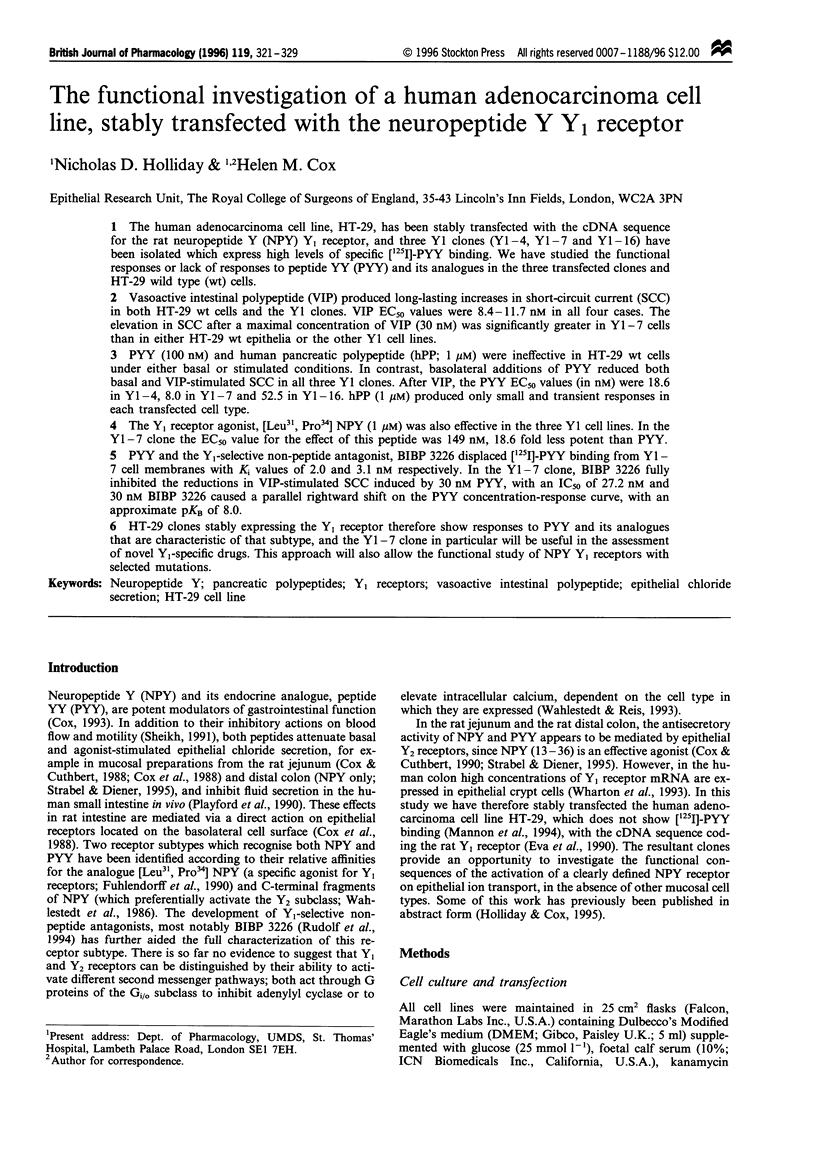
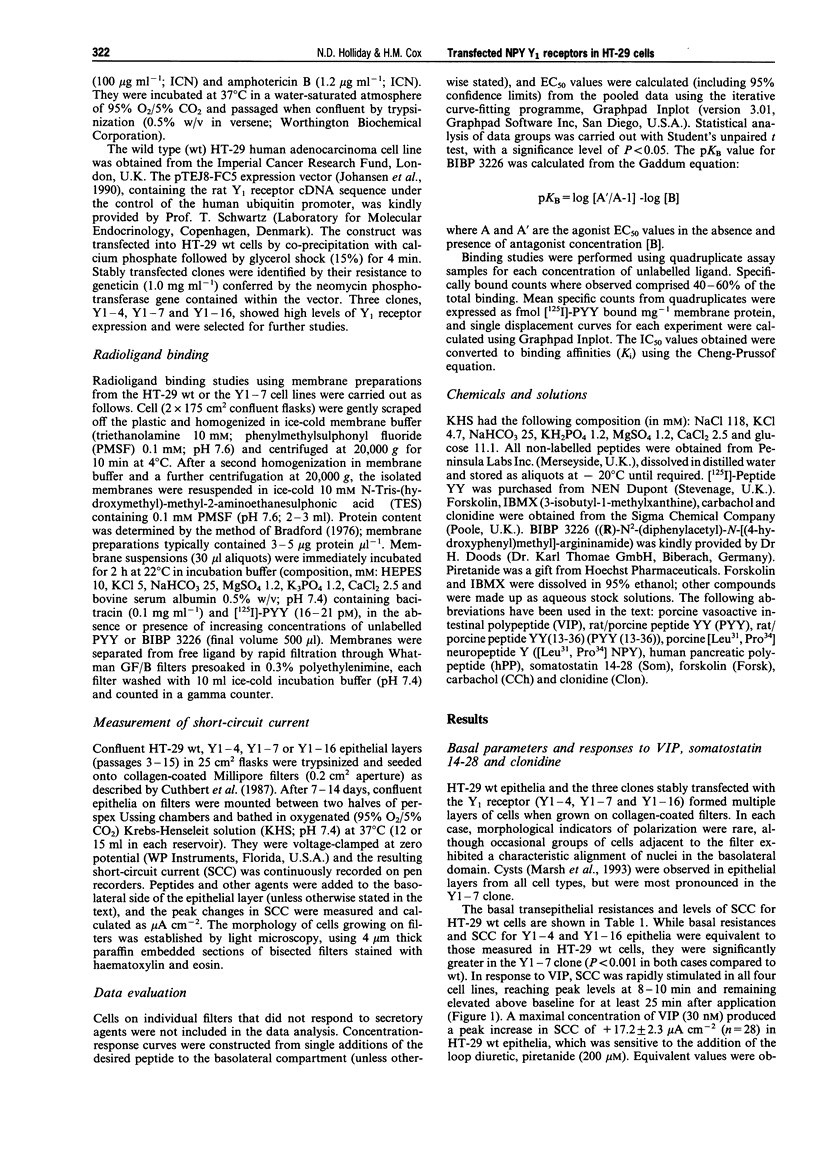
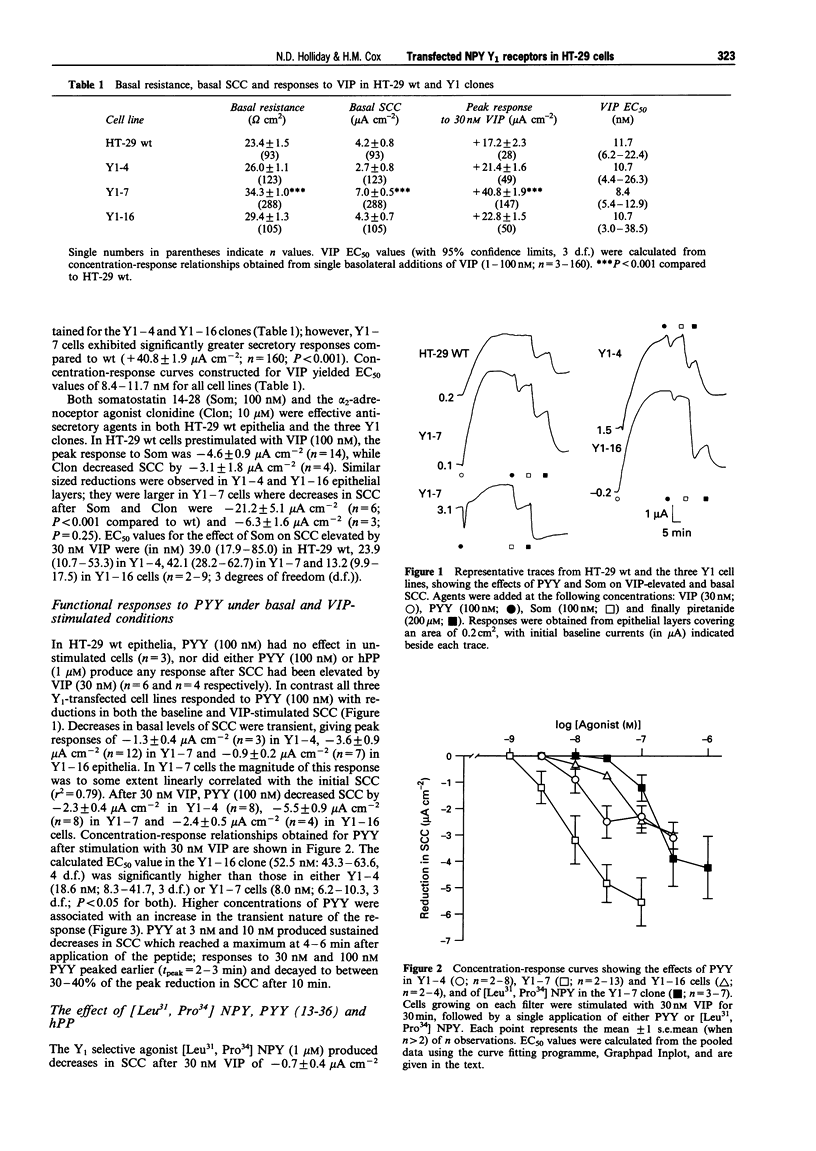
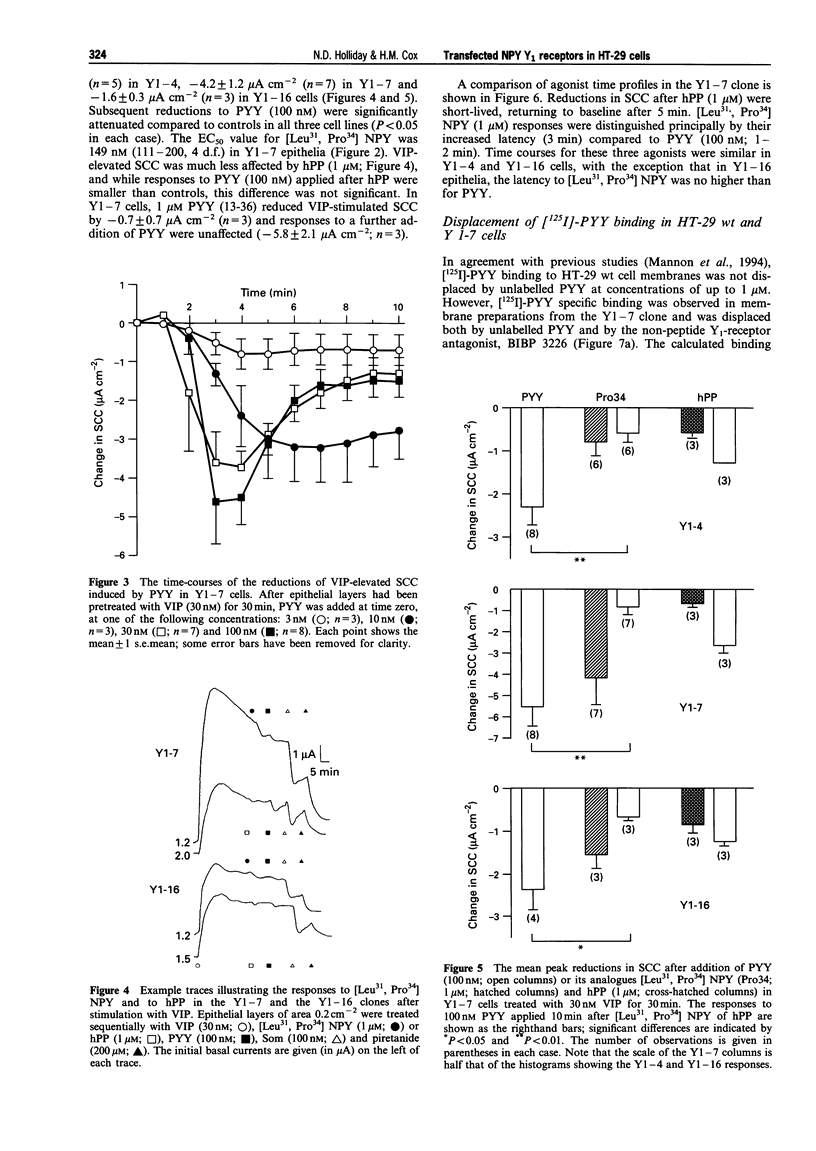
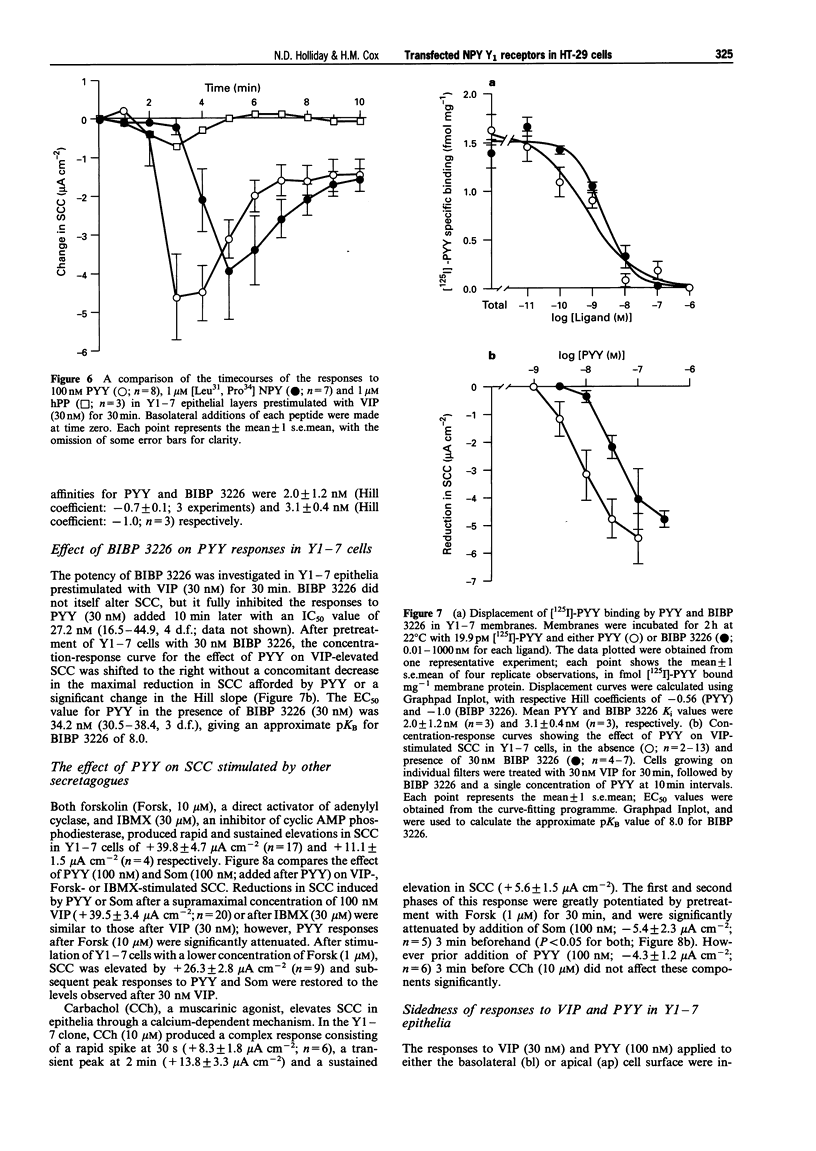
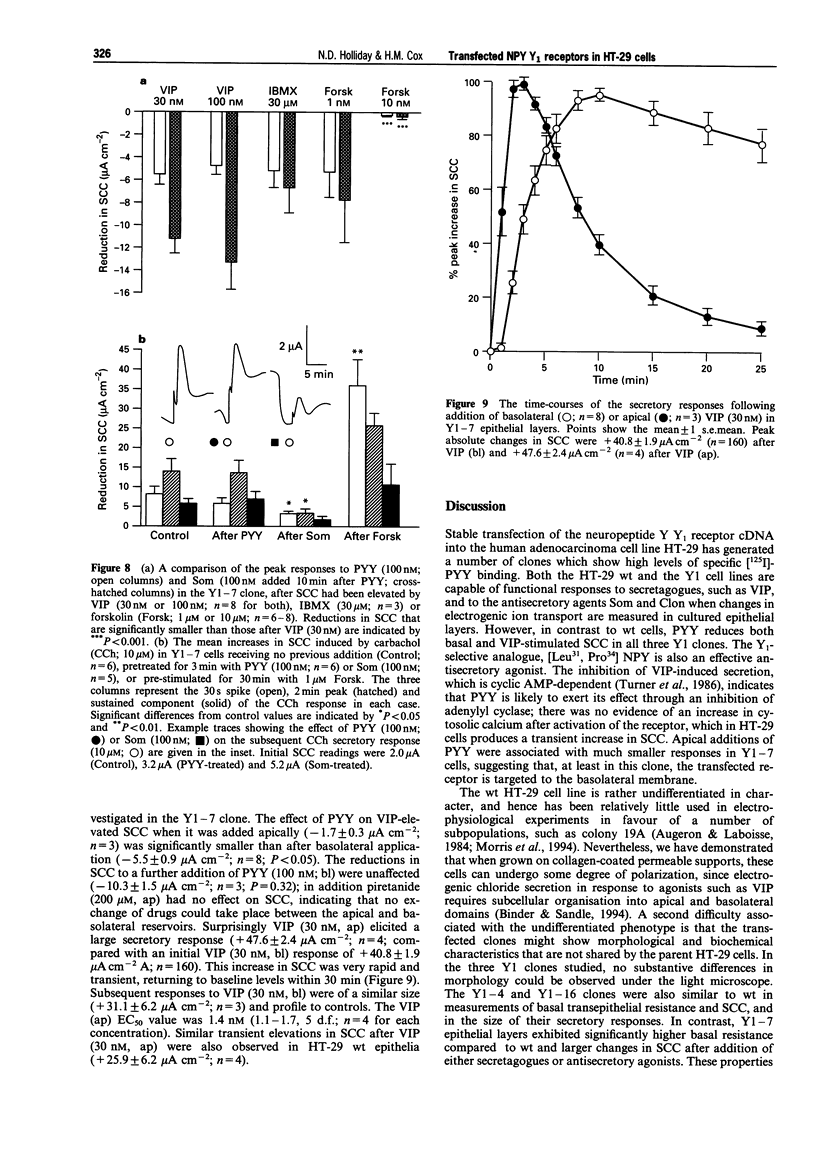
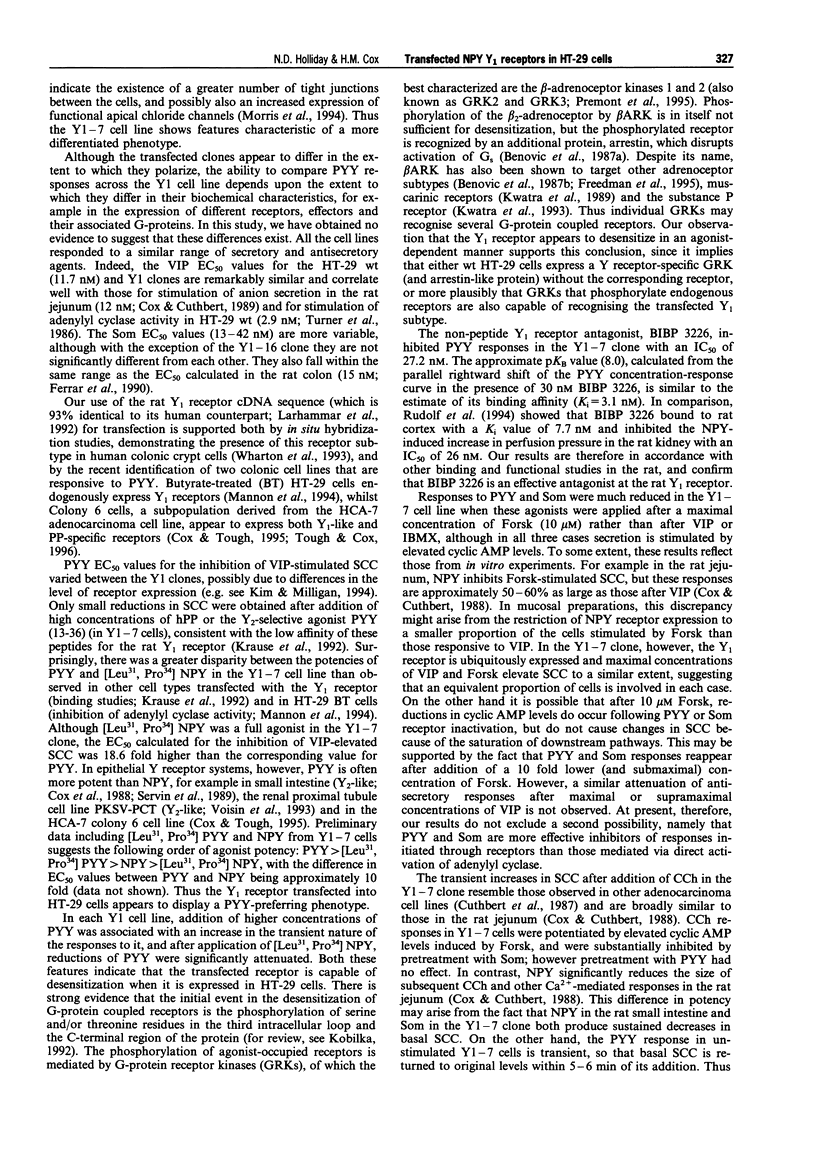
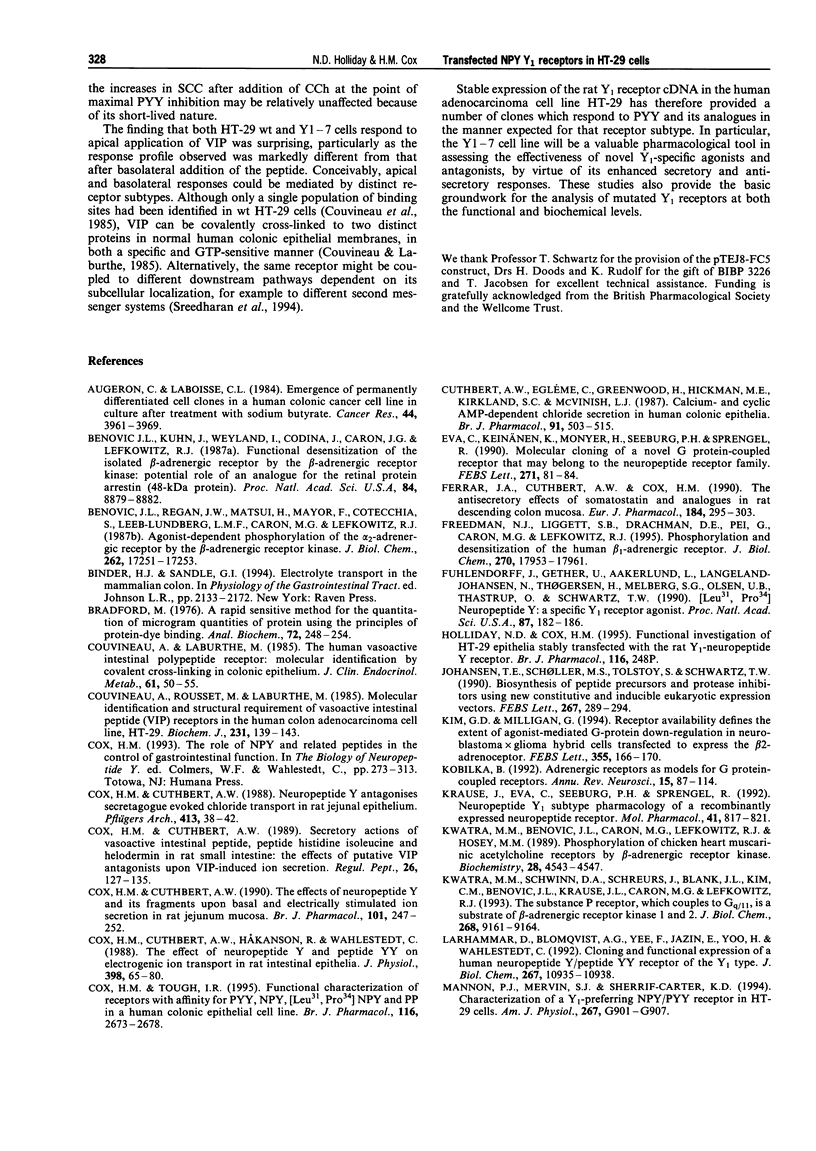
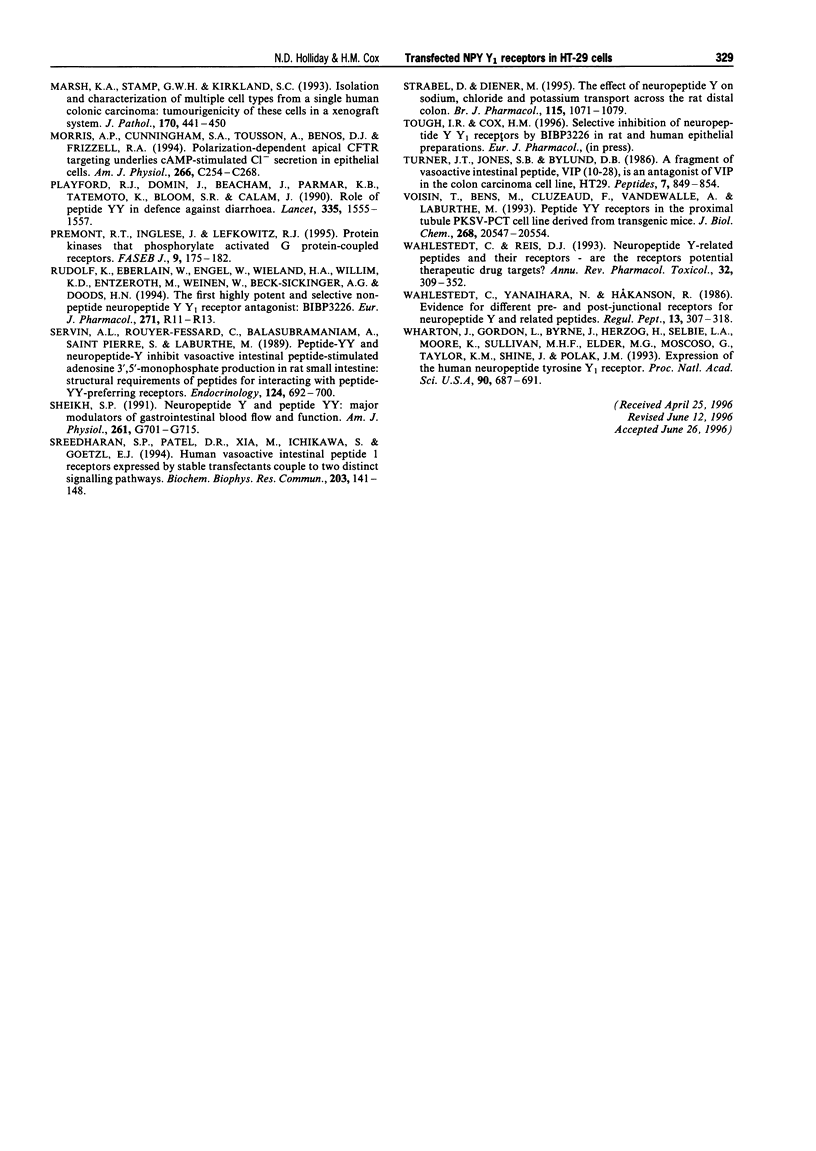
Selected References
These references are in PubMed. This may not be the complete list of references from this article.
- Augeron C., Laboisse C. L. Emergence of permanently differentiated cell clones in a human colonic cancer cell line in culture after treatment with sodium butyrate. Cancer Res. 1984 Sep;44(9):3961–3969. [PubMed] [Google Scholar]
- Benovic J. L., Kühn H., Weyand I., Codina J., Caron M. G., Lefkowitz R. J. Functional desensitization of the isolated beta-adrenergic receptor by the beta-adrenergic receptor kinase: potential role of an analog of the retinal protein arrestin (48-kDa protein). Proc Natl Acad Sci U S A. 1987 Dec;84(24):8879–8882. doi: 10.1073/pnas.84.24.8879. [DOI] [PMC free article] [PubMed] [Google Scholar]
- Benovic J. L., Regan J. W., Matsui H., Mayor F., Jr, Cotecchia S., Leeb-Lundberg L. M., Caron M. G., Lefkowitz R. J. Agonist-dependent phosphorylation of the alpha 2-adrenergic receptor by the beta-adrenergic receptor kinase. J Biol Chem. 1987 Dec 25;262(36):17251–17253. [PubMed] [Google Scholar]
- Bradford M. M. A rapid and sensitive method for the quantitation of microgram quantities of protein utilizing the principle of protein-dye binding. Anal Biochem. 1976 May 7;72:248–254. doi: 10.1006/abio.1976.9999. [DOI] [PubMed] [Google Scholar]
- Couvineau A., Laburthe M. The human vasoactive intestinal peptide receptor: molecular identification by covalent cross-linking in colonic epithelium. J Clin Endocrinol Metab. 1985 Jul;61(1):50–55. doi: 10.1210/jcem-61-1-50. [DOI] [PubMed] [Google Scholar]
- Couvineau A., Rousset M., Laburthe M. Molecular identification and structural requirement of vasoactive intestinal peptide (VIP) receptors in the human colon adenocarcinoma cell line, HT-29. Biochem J. 1985 Oct 1;231(1):139–143. doi: 10.1042/bj2310139. [DOI] [PMC free article] [PubMed] [Google Scholar]
- Cox H. M., Cuthbert A. W., Håkanson R., Wahlestedt C. The effect of neuropeptide Y and peptide YY on electrogenic ion transport in rat intestinal epithelia. J Physiol. 1988 Apr;398:65–80. doi: 10.1113/jphysiol.1988.sp017029. [DOI] [PMC free article] [PubMed] [Google Scholar]
- Cox H. M., Cuthbert A. W. Neuropeptide Y antagonises secretagogue evoked chloride transport in rat jejunal epithelium. Pflugers Arch. 1988 Nov;413(1):38–42. doi: 10.1007/BF00581226. [DOI] [PubMed] [Google Scholar]
- Cox H. M., Cuthbert A. W. Secretory actions of vasoactive intestinal polypeptide, peptide histidine isoleucine and helodermin in rat small intestine: the effects of putative VIP antagonists upon VIP-induced ion secretion. Regul Pept. 1989 Sep-Oct;26(2):127–135. doi: 10.1016/0167-0115(89)90004-9. [DOI] [PubMed] [Google Scholar]
- Cox H. M., Cuthbert A. W. The effects of neuropeptide Y and its fragments upon basal and electrically stimulated ion secretion in rat jejunum mucosa. Br J Pharmacol. 1990 Oct;101(2):247–252. doi: 10.1111/j.1476-5381.1990.tb12695.x. [DOI] [PMC free article] [PubMed] [Google Scholar]
- Cox H. M., Tough I. R. Functional characterization of receptors with affinity for PYY, NPY, [Leu31,Pro34]NPY and PP in a human colonic epithelial cell line. Br J Pharmacol. 1995 Nov;116(6):2673–2678. doi: 10.1111/j.1476-5381.1995.tb17225.x. [DOI] [PMC free article] [PubMed] [Google Scholar]
- Cuthbert A. W., Egléme C., Greenwood H., Hickman M. E., Kirkland S. C., MacVinish L. J. Calcium- and cyclic AMP-dependent chloride secretion in human colonic epithelia. Br J Pharmacol. 1987 Jul;91(3):503–515. doi: 10.1111/j.1476-5381.1987.tb11243.x. [DOI] [PMC free article] [PubMed] [Google Scholar]
- Eva C., Keinänen K., Monyer H., Seeburg P., Sprengel R. Molecular cloning of a novel G protein-coupled receptor that may belong to the neuropeptide receptor family. FEBS Lett. 1990 Oct 1;271(1-2):81–84. doi: 10.1016/0014-5793(90)80377-u. [DOI] [PubMed] [Google Scholar]
- Ferrar J. A., Cuthbert A. W., Cox H. M. The antisecretory effects of somatostatin and analogues in rat descending colon mucosa. Eur J Pharmacol. 1990 Aug 10;184(2-3):295–303. doi: 10.1016/0014-2999(90)90621-c. [DOI] [PubMed] [Google Scholar]
- Freedman N. J., Liggett S. B., Drachman D. E., Pei G., Caron M. G., Lefkowitz R. J. Phosphorylation and desensitization of the human beta 1-adrenergic receptor. Involvement of G protein-coupled receptor kinases and cAMP-dependent protein kinase. J Biol Chem. 1995 Jul 28;270(30):17953–17961. doi: 10.1074/jbc.270.30.17953. [DOI] [PubMed] [Google Scholar]
- Fuhlendorff J., Gether U., Aakerlund L., Langeland-Johansen N., Thøgersen H., Melberg S. G., Olsen U. B., Thastrup O., Schwartz T. W. [Leu31, Pro34]neuropeptide Y: a specific Y1 receptor agonist. Proc Natl Acad Sci U S A. 1990 Jan;87(1):182–186. doi: 10.1073/pnas.87.1.182. [DOI] [PMC free article] [PubMed] [Google Scholar]
- Johansen T. E., Schøller M. S., Tolstoy S., Schwartz T. W. Biosynthesis of peptide precursors and protease inhibitors using new constitutive and inducible eukaryotic expression vectors. FEBS Lett. 1990 Jul 16;267(2):289–294. doi: 10.1016/0014-5793(90)80947-h. [DOI] [PubMed] [Google Scholar]
- Kim G. D., Milligan G. Receptor availability defines the extent of agonist-mediated G-protein down-regulation in neuroblastoma x glioma hybrid cells transfected to express the beta 2-adrenoceptor. FEBS Lett. 1994 Nov 28;355(2):166–170. doi: 10.1016/0014-5793(94)01169-9. [DOI] [PubMed] [Google Scholar]
- Kobilka B. Adrenergic receptors as models for G protein-coupled receptors. Annu Rev Neurosci. 1992;15:87–114. doi: 10.1146/annurev.ne.15.030192.000511. [DOI] [PubMed] [Google Scholar]
- Krause J., Eva C., Seeburg P. H., Sprengel R. Neuropeptide Y1 subtype pharmacology of a recombinantly expressed neuropeptide receptor. Mol Pharmacol. 1992 May;41(5):817–821. [PubMed] [Google Scholar]
- Kwatra M. M., Benovic J. L., Caron M. G., Lefkowitz R. J., Hosey M. M. Phosphorylation of chick heart muscarinic cholinergic receptors by the beta-adrenergic receptor kinase. Biochemistry. 1989 May 30;28(11):4543–4547. doi: 10.1021/bi00437a005. [DOI] [PubMed] [Google Scholar]
- Kwatra M. M., Schwinn D. A., Schreurs J., Blank J. L., Kim C. M., Benovic J. L., Krause J. E., Caron M. G., Lefkowitz R. J. The substance P receptor, which couples to Gq/11, is a substrate of beta-adrenergic receptor kinase 1 and 2. J Biol Chem. 1993 May 5;268(13):9161–9164. [PubMed] [Google Scholar]
- Larhammar D., Blomqvist A. G., Yee F., Jazin E., Yoo H., Wahlested C. Cloning and functional expression of a human neuropeptide Y/peptide YY receptor of the Y1 type. J Biol Chem. 1992 Jun 5;267(16):10935–10938. [PubMed] [Google Scholar]
- Mannon P. J., Mervin S. J., Sheriff-Carter K. D. Characterization of a Y1-preferring NPY/PYY receptor in HT-29 cells. Am J Physiol. 1994 Nov;267(5 Pt 1):G901–G907. doi: 10.1152/ajpgi.1994.267.5.G901. [DOI] [PubMed] [Google Scholar]
- Marsh K. A., Stamp G. W., Kirkland S. C. Isolation and characterization of multiple cell types from a single human colonic carcinoma: tumourigenicity of these cell types in a xenograft system. J Pathol. 1993 Aug;170(4):441–450. doi: 10.1002/path.1711700407. [DOI] [PubMed] [Google Scholar]
- Morris A. P., Cunningham S. A., Tousson A., Benos D. J., Frizzell R. A. Polarization-dependent apical membrane CFTR targeting underlies cAMP-stimulated Cl- secretion in epithelial cells. Am J Physiol. 1994 Jan;266(1 Pt 1):C254–C268. doi: 10.1152/ajpcell.1994.266.1.C254. [DOI] [PubMed] [Google Scholar]
- Playford R. J., Domin J., Beacham J., Parmar K. B., Tatemoto K., Bloom S. R., Calam J. Preliminary report: role of peptide YY in defence against diarrhoea. Lancet. 1990 Jun 30;335(8705):1555–1557. doi: 10.1016/0140-6736(90)91378-n. [DOI] [PubMed] [Google Scholar]
- Premont R. T., Inglese J., Lefkowitz R. J. Protein kinases that phosphorylate activated G protein-coupled receptors. FASEB J. 1995 Feb;9(2):175–182. doi: 10.1096/fasebj.9.2.7781920. [DOI] [PubMed] [Google Scholar]
- Rudolf K., Eberlein W., Engel W., Wieland H. A., Willim K. D., Entzeroth M., Wienen W., Beck-Sickinger A. G., Doods H. N. The first highly potent and selective non-peptide neuropeptide Y Y1 receptor antagonist: BIBP3226. Eur J Pharmacol. 1994 Dec 27;271(2-3):R11–R13. doi: 10.1016/0014-2999(94)90822-2. [DOI] [PubMed] [Google Scholar]
- Servin A. L., Rouyer-Fessard C., Balasubramaniam A., Saint Pierre S., Laburthe M. Peptide-YY and neuropeptide-Y inhibit vasoactive intestinal peptide-stimulated adenosine 3',5'-monophosphate production in rat small intestine: structural requirements of peptides for interacting with peptide-YY-preferring receptors. Endocrinology. 1989 Feb;124(2):692–700. doi: 10.1210/endo-124-2-692. [DOI] [PubMed] [Google Scholar]
- Sheikh S. P. Neuropeptide Y and peptide YY: major modulators of gastrointestinal blood flow and function. Am J Physiol. 1991 Nov;261(5 Pt 1):G701–G715. doi: 10.1152/ajpgi.1991.261.5.G701. [DOI] [PubMed] [Google Scholar]
- Sreedharan S. P., Patel D. R., Xia M., Ichikawa S., Goetzl E. J. Human vasoactive intestinal peptide1 receptors expressed by stable transfectants couple to two distinct signaling pathways. Biochem Biophys Res Commun. 1994 Aug 30;203(1):141–148. doi: 10.1006/bbrc.1994.2160. [DOI] [PubMed] [Google Scholar]
- Strabel D., Diener M. The effect of neuropeptide Y on sodium, chloride and potassium transport across the rat distal colon. Br J Pharmacol. 1995 Jul;115(6):1071–1079. doi: 10.1111/j.1476-5381.1995.tb15920.x. [DOI] [PMC free article] [PubMed] [Google Scholar]
- Turner J. T., Jones S. B., Bylund D. B. A fragment of vasoactive intestinal peptide, VIP(10-28), is an antagonist of VIP in the colon carcinoma cell line, HT29. Peptides. 1986 Sep-Oct;7(5):849–854. doi: 10.1016/0196-9781(86)90105-1. [DOI] [PubMed] [Google Scholar]
- Voisin T., Bens M., Cluzeaud F., Vandewalle A., Laburthe M. Peptide YY receptors in the proximal tubule PKSV-PCT cell line derived from transgenic mice. Relation with cell growth. J Biol Chem. 1993 Sep 25;268(27):20547–20554. [PubMed] [Google Scholar]
- Wahlestedt C., Reis D. J. Neuropeptide Y-related peptides and their receptors--are the receptors potential therapeutic drug targets? Annu Rev Pharmacol Toxicol. 1993;33:309–352. doi: 10.1146/annurev.pa.33.040193.001521. [DOI] [PubMed] [Google Scholar]
- Wahlestedt C., Yanaihara N., Håkanson R. Evidence for different pre-and post-junctional receptors for neuropeptide Y and related peptides. Regul Pept. 1986 Feb;13(3-4):307–318. doi: 10.1016/0167-0115(86)90048-0. [DOI] [PubMed] [Google Scholar]
- Wharton J., Gordon L., Byrne J., Herzog H., Selbie L. A., Moore K., Sullivan M. H., Elder M. G., Moscoso G., Taylor K. M. Expression of the human neuropeptide tyrosine Y1 receptor. Proc Natl Acad Sci U S A. 1993 Jan 15;90(2):687–691. doi: 10.1073/pnas.90.2.687. [DOI] [PMC free article] [PubMed] [Google Scholar]


